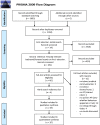The validity of using analogue patients in practitioner-patient communication research: systematic review and meta-analysis
- PMID: 22700392
- PMCID: PMC3475831
- DOI: 10.1007/s11606-012-2111-8
The validity of using analogue patients in practitioner-patient communication research: systematic review and meta-analysis
Abstract
When studying the patient perspective on communication, some studies rely on analogue patients (patients and healthy subjects) who rate videotaped medical consultations while putting themselves in the shoes of the video-patient. To describe the rationales, methodology, and outcomes of studies using video-vignette designs in which videotaped medical consultations are watched and judged by analogue patients. Pubmed, Embase, Psychinfo and CINAHL databases were systematically searched up to February 2012. Data was extracted on: study characteristics and quality, design, rationales, internal and external validity, limitations and analogue patients' perceptions of studied communication. A meta-analysis was conducted on the distribution of analogue patients' evaluations of communication. Thirty-four studies were included, comprising both scripted and clinical studies, of average-to-superior quality. Studies provided unspecific, ethical as well as methodological rationales for conducting video-vignette studies with analogue patients. Scripted studies provided the most specific methodological rationales and tried the most to increase and test internal validity (e.g. by performing manipulation checks) and external validity (e.g. by determining identification with video-patient). Analogue patients' perceptions of communication largely overlap with clinical patients' perceptions. The meta-analysis revealed that analogue patients' evaluations of practitioners' communication are not subject to ceiling effects. Analogue patients' evaluations of communication equaled clinical patients' perceptions, while overcoming ceiling effects. This implies that analogue patients can be included as proxies for clinical patients in studies on communication, taken some described precautions into account. Insights from this review may ease decisions about including analogue patients in video-vignette studies, improve the quality of these studies and increase knowledge on communication from the patient perspective.
Conflict of interest statement
L. M van Vliet has no conflicts of interest to declare.
E. van der Wall has no conflicts of interest to declare.
A. Albada has no conflicts of interest to declare.
P. Spreeuwenberg has no conflicts of interest to declare.
W. Verheul has no conflicts of interest to declare.
J. M Bensing has no conflicts of interest to declare.
Figures
References
Publication types
MeSH terms
LinkOut - more resources
Full Text Sources
Other Literature Sources
Medical


